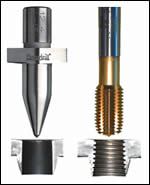Chip-Free Drilling Process Creates Holes And Bushings
This chip-free drilling technique can create both a hole and support bushing in thin-walled parts in one machining operation.
Share







Hwacheon Machinery America, Inc.
Featured Content
View More
Drilling holes in thin-walled parts isn’t hugely challenging. The process might require some means of workpiece support to counteract the pressure of the drill as it begins to penetrate the material. Depending on the application, the hole may also need to be deburred or chamfered.
Oftentimes, though, these holes must accept a bearing or fastener for component assembly. With conventional drilling, the hole’s thickness equals that of the workpiece, which likely isn’t suitable for threading or to provide sufficient support for a bearing sleeve. For that reason, it is often necessary to weld or rivet a nut to the workpiece, or install a special insert into the hole. The Flowdrill from Flowdrill Inc. (St. Louis, Missouri) eliminates the need for such devices by using a chip-free drilling technique that creates both a hole and support bushing in one machining operation.
The Flowdrill concept uses a conical drill that contacts material with high axial (downward) pressure and rotational speed. The frictional heat the drill generates softens the material, making it malleable enough for the drill to pierce the workpiece and form a collar and bushing around the hole. The total thickness of the collar (created on the top of the surface) and bushing (located under the surface) can be up to three times the workpiece thickness. This increased thickness offers support for a bearing or can be tapped with a similar Flowtap operation. The process works for wall thicknesses from 0.02 to 0.5 inch in mild and stainless steels, titanium, aluminum, copper, brass and various other malleable materials. Common applications include auto exhaust, steering and frame components; pressure and water tanks; pipes and tubing; HVAC manifolds; and metal furniture.
The tungsten carbide Flowdrills are available in diameters from 0.06 to 2 inches and can hold 0.0005-inch repeatability. They can be used on standard drilling machines or CNC machine tools, operating at power levels between 1.5 to 3.5 kW and spindle speeds from 1,000 to 3,500 rpm. The cutting parameters for each application will vary depending on hole diameter and workpiece material and thickness. To optimize hole quality and precision, lubrication must be applied prior to each operation. This can be done manually or via an automatic spraying system. Typical cycle times range from 2 to 6 seconds. Flowdrill collet toolholders are available with a #2 and #3 Morse Taper shank or a 20-mm straight cylindrical shank.
For applications requiring a smooth joining surface or a chamfered hole, flat Flowdrill versions can be used to cut the collar that is formed on the surface of the workpiece. Fluted-tip Flowdrills are recommended for coated materials because the tip helps remove the coating at the start of the drilling operation. Fluted Flowdrills also help prevent the deformation of thin workpieces that can occur because of the drill’s downward pressure. This distortion can also be avoided by drilling a small starter hole.
Flowtap roll forming taps can be used to create various standard, metric and NPT thread profiles. Because they form the threads rather than cut them, a compressed structure is created. This structure offers high pull-out strength and torque specifications.
Related Content
Selecting a Thread Mill That Matches Your Needs
Threading tools with the flexibility to thread a broad variety of holes provide the agility many shops need to stay competitive. They may be the only solution for many difficult materials.
Read MoreCustom PCD Tools Extend Shop’s Tool Life Upward of Ten Times
Adopting PCD tooling has extended FT Precision’s tool life from days to months — and the test drill is still going strong.
Read MoreHigh-Feed Machining Dominates Cutting Tool Event
At its New Product Rollout, Ingersoll showcased a number of options for high-feed machining, demonstrating the strategy’s growing footprint in the industry.
Read MoreShoulder Milling Cuts Racing Part's Cycle Time By Over 50%
Pairing a shoulder mill with a five-axis machine has cut costs and cycle times for one of TTI Machine’s parts, enabling it to support a niche racing community.
Read MoreRead Next
Registration Now Open for the Precision Machining Technology Show (PMTS) 2025
The precision machining industry’s premier event returns to Cleveland, OH, April 1-3.
Read More5 Rules of Thumb for Buying CNC Machine Tools
Use these tips to carefully plan your machine tool purchases and to avoid regretting your decision later.
Read MoreBuilding Out a Foundation for Student Machinists
Autodesk and Haas have teamed up to produce an introductory course for students that covers the basics of CAD, CAM and CNC while providing them with a portfolio part.
Read More





































.png;maxWidth=300;quality=90)













